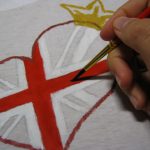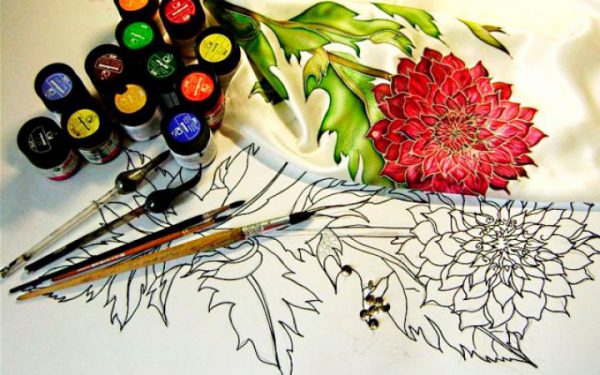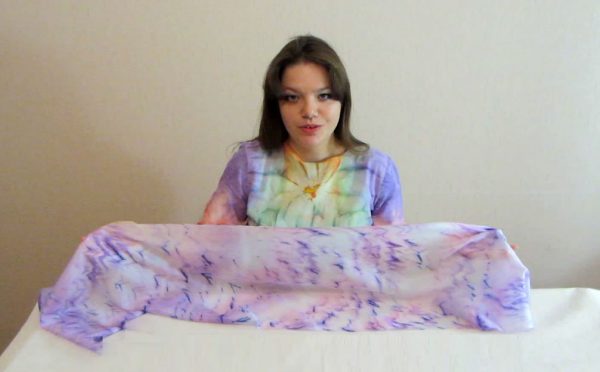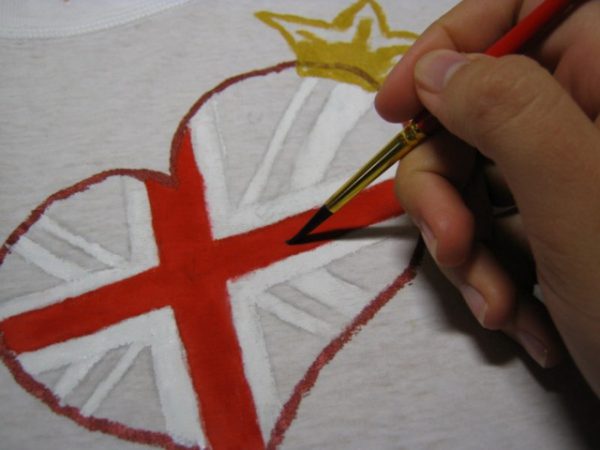Now painting on fabric has become a popular type of hobby. This is a real art, thanks to which you can give clothes, shoes, textiles and other products originality and beauty. It is best to make drawings with acrylic paints - they are of the highest quality and allow you to get the perfect result. There are various techniques for painting with paints, which should be familiar with needlewomen.
- Properties and features of acrylic dyes
- Suitable fabric
- Silk marking on paint
- Textile pointer on paint
- Types of painting with acrylic paints
- Hot batik
- Cold batik
- Nodal Batik
- Shibori Technique
- Free painting
- Airbrush painting
- The history of the appearance of batik technology
- Acrylic Prints - Fulfillment
- Copying a picture from paper
- Freehand drawing on fabric
- Stenciling
- Screen printing
- Tips - what to consider in work
- Wash recommendations

Properties and features of acrylic dyes
Acrylic for drawing is one of the types paints for fabric, a polymer composition that does not penetrate into the fibers, but covers them from the outside. Acrylic colors are available in rich colors, easily mixed with each other, allowing you to get unique shades. Since this staining is not afraid of moisture, it can even be done on jackets, raincoats, raincoats, not to mention jeans, scarves, bags, t-shirts. Hand painting with acrylic looks great on tablecloths, panels. It is not recommended to draw at home on these types of things:
- underwear - there is a risk of allergies;
- bedding - due to frequent washing, it quickly fades;
- dry cleaning products - due to possible damage to the design;
- things for young children attending kindergarten - there is a high risk of allergies in toddlers.
Acrylic is ideal for beginners. Finished cloths dry quickly, and the price of paints is low - there is the opportunity to experiment. Other properties of acrylic dyes are as follows:
- there are no harmful chemicals in the composition - there are vegetable or artificial resins, pigments, water, plasticizers, binders for consistency uniformity;
- the texture of the paint resembles the tempera with which icons are painted, but dries much faster and creates a protective film on the surface (the latter is so durable that things can be washed in a washing machine, folded, stored for a long time);
- after applying paint to the fabric, its fibers become denser, but this area of matter loses its elasticity;
- over time, the quality of acrylic deteriorates, so you should use paints only during the normal shelf life.
to contents ↑Acrylic colors are diluted with water, but specialists prefer the use of special solvents. Such substances help to make images glossy, and when water is introduced, the picture will become dull. To fix the paints it is better to use dry heat - walk through the fabric with an iron. You can buy colors in art stores, there is also additional equipment (brushes, palettes, templates, stencils).
Suitable fabric
DIY colors are easy to do. It is important to choose a fabric suitable for this so that it matches the type of dye. The choice of matter also depends on the technique of painting things.So, hot batik involves the use of natural fabrics - cotton, linen, wool, viscose, denim. This method allows only such fibers to be dyed, while the artificial ones will remain in their original color. Therefore, mixed materials are not recommended.
to contents ↑Silk marking on paint
If such a designation is on the color, then increasing the stiffness of the fabric is not noted, because the tool is suitable even for thin matter. Similar dyes can be used for silk, chiffon, and cambric. Most of these fabrics respond well to the technique of cold batik.
Textile pointer on paint
Such colors are suitable for hard, dense fabrics - suede, leather, furniture materials. For dark textiles, dyes with the appropriate mark should be selected.
to contents ↑Types of painting with acrylic paints
Only a clean cloth or thing should be dyed, so it is washed before the work starts, after it is thoroughly dried, ironed. In some painting techniques, you need to pull the material onto a special frame (for needlewomen it is called the hoop), although you can make any convenient device yourself. The fabric for work is laid out in a well-lit place, while the area for dyeing should be in the center.
to contents ↑Hot batik
For hot coloring, natural dyes used to be used - Indian henna, tea, turmeric and even potassium permanganate, but now there are many more persistent, high-quality colors on sale. For hot batik, molten wax is used, which allows you to get structured images with different combinations of shades.
The meaning of the technique is that after removing it, a lighter or darker pattern remains, or even a white picture. Chanting is used for waxing - a tool that applies original wax patterns. It looks like a small vessel with several spouts and a handle.
For hot batik, first prepare the wax mixture. It is implemented in finished form or made with your own hands from pine resin, paraffin, beeswax, fat, dammar resin. Beginners are advised to first try applying molten wax from a regular candle to the fabric to practice.
The procedure is as follows:
- prepare a draft picture - draw a picture on paper or print on a printer;
- transfer the pattern to the fabric in any convenient way (spot technique, through tracing paper, carbon paper, etc.);
- places of the drawing that must be left unpainted, greased with hot wax, allowed to dry completely (the spot should be transparent and dark, but not white and matte);
- pour the fabric with a dye solution, withstand the right time;
- remove wax;
- if necessary, cover already painted areas with new wax, and paint a light spot with a different color;
- repeat the cycle until the desired combinations are obtained (up to black).
To remove wax, use paper and an iron to heat the fabric and gently separate the substance. This technique is time-consuming, so it is better to first see a master class on the Internet.
to contents ↑
Cold batik
The difference between this technique and the "hot" one is that instead of wax, a special substance is used that does not pass color. The second name of cold batik is reservation, and the compositions are called backup.
First, the pattern is encircled with this substance, then other parts of the fabric are painted over. Contours prevent dyes from flowing onto the image. After complete drying of the matter, the reserve composition is removed. The result is a contrast (vital) staining. The easiest way to tint products in this technique for finished stencils.
to contents ↑Nodal Batik
You can paint the fabric in nodular technique, as a result of unexpected effects and original patterns. They are formed due to small nodules that are unevenly stained. Beginning needlewomen and artists are recommended to use this type of batik. Especially successful are dresses, tablecloths, napkins, t-shirts.
The procedure is as follows:
- make free background painting (if required);
- dry the item, lay the pebbles on it, dress them with threads in knots (according to the idea);
- twist the whole fabric tightly from 2 sides, fold it in 2-3 layers, tie it again with threads;
- immerse in a container with paint, withstand the right time;
- remove, dry the product.
Shibori Technique
This method is a type of nodular batik. The only difference is that the fabric folds in a certain way, reminiscent of origami. Also, the technique involves the use of additional effects - sprinkling salt, sprinkling alcohol.
to contents ↑Free painting
The technique resembles the usual painting of fabric with watercolors or gouache. On matter, the result can be a real picture or individual drawings, details. Here, the artist’s talent is fully manifested, because according to the template, painting will not work. So that the paint does not flow, the fabric is pre-soaked in saline for 2-3 hours. For the successful prescribing of shades, the use of redundant compositions is allowed. If they are not, it is better to pre-fabric primer:
- mix gelatin, PVA, starch equally;
- apply to the fabric with a brush;
- dry, but not completely;
- get to work.
to contents ↑A kind of free painting is raw painting. It gives the effect of flowing from one color to another, gives a feeling of airiness. Drawing is performed on wet tissue without the use of stencil technique (without patterns). You can not only perform brush strokes, but also inflate the paint through a straw for a cocktail, after giving the drops the desired shape.
Airbrush painting
For this method of staining, you will need a device for spraying paint - an airbrush. Changing the angle of application, you can get a variety of shades. To use airbrushing, you must have certain artistic skills.
The history of the appearance of batik technology
Batik is several hundred years old. Over time, the technique became more complicated, improved and in different countries had its own characteristics. Indonesia is considered to be the birthplace of batik, but for the first time a description of the method was made in Holland in the 17th century. Very ancient tissue samples were discovered in Egypt - they were made around the 5th century. Batik in ancient times was common in Japan, China and other Asian countries, and in the Middle Ages became incredibly popular with European artists.
to contents ↑Acrylic Prints - Fulfillment
The most reliable method of creating an original thing is painting with acrylic tones. You can apply a variety of methods of applying paints.
Copying a picture from paper
In this case, being an artist to create masterpieces is not necessary. It is enough to have accuracy to clearly circle the pattern on the fabric. It is printed on the printer, making the contours bold, dark (otherwise they will not be visible through the fabric). Next, the thing is pulled onto a cardboard or a sheet of plywood, put an embossed pattern between the layers, fixed with pins, circle the drawing with a simple pencil or a special marker for matter. After that you can start drawing the image with paints.
to contents ↑Freehand drawing on fabric
If you have artistic abilities and imagination, you can perform a drawing without a template, manually. Professionals work directly with paints, it is better for a beginner to first draw the contours with a simple pencil. This method is especially good if some lightness, carelessness in the picture is assumed.
Stenciling
Stencils are sold in specialized stores in large quantities. It is very convenient to use this technique if you need to copy the same picture repeatedly (form for a team, napkins, etc.). The stencil is applied to the fabric, fixed with pins, paper clips and outlined with paints.
Screen printing
It is used to create complex drawings, multi-color images. The method involves the use of special inks and screen printing nets, and a roller and other tools will also be required. It is better to give the product to the workshop, where all the work will be performed efficiently.
to contents ↑Tips - what to consider in work
To paint on a fabric basis came out "excellent", it is worth following a number of important tips and recommendations:
- purchase only high-quality paints in specialized stores (too cheap colors can be fakes);
- pay attention to the expiration date - it should be normal;
- get acquainted with the composition of paints - if they are good, they do not contain toxic components, heavy metals, there is no unpleasant odor;
- Before painting a large canvas, do a color test on a small area, evaluate the work after the paint has completely dried;
- for work, use brushes with synthetic nap, rollers, sponges;
- apply each new coat after drying the previous one;
- in a day, fix the pattern with an iron - iron it for at least 5 minutes;
- high-quality products do not disperse into matter, persistent, do not collapse from water after solidification.
Wash recommendations
For washing use only non-aggressive surfactants and water with a temperature of up to 35-40 degrees. It is strictly forbidden to use bleaches that destroy paint. Small items are best washed by hand, do not wring out, do not twist them, but carefully hang them on the back of a chair for drying.
Large items are machine washable, including delicate mode. Subject to these simple rules, clothing or other products will last a long time without loss of color and quality.













